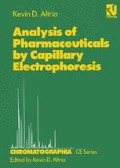Abstract
Capillary electrophoresis is now beginning to become established as an appropriate means to determine components at trace levels. In the area of pharmaceutical analysis, this may involve determination of residues of drug or detergent following formulation manufacture. Additionally, CE can be used to monitor operator exposure levels or environmental levels. The sensitivity disadvantage of CE, compared to HPLC, can be overcome in various ways. The features of CE testing in these areas such as simplicity, the ability to simultaneously monitor levels of several compounds, reduced analysis time and costs can make analysis very attractive.
Access this chapter
Tax calculation will be finalised at checkout
Purchases are for personal use only
Preview
Unable to display preview. Download preview PDF.
References
Altria KD, Creasey E, and Howells JS, Routine trace level determinations of pharmaceutical and detergent residues J. Liq. Chromatogr. in press.
Cavallaro A, Piangerelli V, Nerini F, Cavalli S, and Reschiotto C, Selective determination of aromatic amines in water samples by capillary zone electrophoresis and solid phase extraction, J. Chromatogr. A, 709 (1995) 361–366.
Altria KD and Hadgett T, An evaluation of the use of capillary electrophoresis to monitor trace drug residue levels following the manufacture of pharmaceuticals, Chromatographia, 40 (1995) 23–27.
Altria KD, Bryant S, and Kooyman O, unpublished data.
Mussenbrock E and Kleibohmer W, Separation strategies for the determination of residues of explosives in soils using micellar electrokinetic capillary chromatography, J. Microcol. Sepn., 7 (1995) 107–116.
Dinelli G, Bonetti A, Catizone P, and Galletti G C, Separation and detection of herbicides in water by micellar electrokinetic capillary chromatography, J. Chromatogr. B, 656 (1994) 275–280.
Wynia GS, Windhorst G, Post PC, and Mars FA, Development and validation of a capillary electrophoresis method within a pharmaceutical quality control environment and comparison with high-performance liquid chromatography, J. Chromatogr. A, 773 (1997) 339–350.
Ackermans MT, Beckers JL, Everaerts FM, Hoogland H, and Tomassen MJH, Determination of sulphonamides in pork meat extracts by capillary zone electrophoresis, J. Chromatogr., 596 (1992) 101–109.
Altria KD, Gill I, Howells J, Luscombe CN, and Williams RZ, Trace analysis of detergent residues by Capillary Electrophoresis, Chromatographia, 40 (1995) 527–531.
Huang TS, Du WX. Marshall MR, and Wei CI, Determination of Oxytetracycline in raw and cooked channel catfish by capillary electrophoresis, J. Agric. Food Chem., 45 (1997) 2602–2605.
Leone A M, Francis P L, Rhodes P, and Moncada S, A rapid and simple method for the measurement of nitrite and nitrate in plasma by high performance capillary electrophoresis, Biochem. Biophys. Res. Comm., 200 (1994) 951–957.
Gibbons J M and Hoke S H, Capillary zone electrophoresis with indirect UV detection: determination of sodium dodecyl sulfate in simulated stream water, JHRCC, 17 (1994) 665–667.
Author information
Authors and Affiliations
Rights and permissions
Copyright information
© 1998 Friedr. Vieweg & Sohn Verlagsgesellschaft mbH, Braunschweig/Wiesbaden
About this chapter
Cite this chapter
Altria, K.D. (1998). Trace Analysis and Residues Determination. In: Analysis of Pharmaceuticals by Capillary Electrophoresis. Chromatographia CE Series, vol 2. Vieweg+Teubner Verlag. https://doi.org/10.1007/978-3-322-85011-9_6
Download citation
DOI: https://doi.org/10.1007/978-3-322-85011-9_6
Publisher Name: Vieweg+Teubner Verlag
Print ISBN: 978-3-322-85013-3
Online ISBN: 978-3-322-85011-9
eBook Packages: Springer Book Archive

